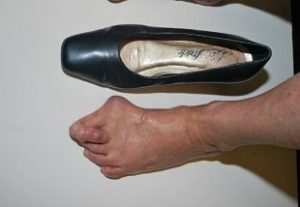

This picture shows a genetic bunion with a crossover second toe. This shoe doesn’t help her out. Look at how wide her foot is, and how narrow her shoe is. This is the perfect example of shoe abuse. At U.S Orthotic Center we create a custom-made orthotic that will complement any show that one wears. insoles for bunions fits need comfort and our body needs support. To avoid the wear and tear on our body. Us orthotics center help and make orthotics that will ease your everyday life.
As it thickens, it starts to look like a big knob sticking out. Protective tissue develops around the bony protrusion, and that tissue can become inflamed and painful. Like the shoes that sometimes stimulate their growth, bunions come in all sizes. They range from a slight bump on the side of your foot to a larger bump with redness and swelling, to a big toe that is so misshapen it seems to be crashing like the Leaning Tower of Pisa onto its neighbor. At that point, you may have trouble fitting into a normal-shaped shoe. As the big toe begins to lean toward the second toe, it may create friction and cause soreness in the second toe as well. Eventually, the thickened joint may fall so far out of alignment that it no longer functions correctly. The end result of all this misalignment? Chronic joint pain.
Bony growth and misalignment don’t disappear. But you can keep the bunion from getting worse, and you may be able to reduce the redness and swelling by removing the source of irritation. Even when its summer and flip flop season come to US orthotic center to get your custom made flip flop orthotics
Proper footwear, properly fitted, is your first line of defense against bunions. Your everyday shoes should be low-heeled with rounded toes. But even a shoe styled for comfort can cause problems if it doesn’t fit. Often people wear too-small shoes or buy their shoes based on the size of the smaller foot. (Or they select the shoe size they wore in high school!) Constant pressure from a too-small shoe irritates the big-toe joint, causing inflammation.
Pronation–the tendency of your foot to lean inward–is another contributor to bunion growth because it puts pressure on the big toe joint and the first metatarsal bone. That’s why a simple over-the-counter arch support is sometimes a good fix. It may alleviate pain by keeping your foot from rolling inward. Better yet, the bunion may not progress to a more serious and painful stage. In any way, insoles-for-bunions may work perfectly for your needs.